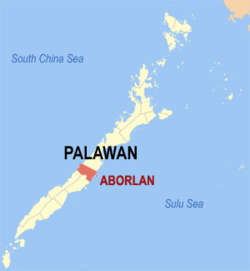Top Qs
Timeline
Chat
Perspective
Aborlan
Municipality in Palawan, Philippines From Wikipedia, the free encyclopedia
Remove ads
Aborlan, officially the Municipality of Aborlan (Tagalog: Bayan ng Aborlan), is a municipality in the province of Palawan , Philippines. According to the 2020 census, it has a population of 38,736 people.
Aborlan is the province's only town with an agricultural college, now called Western Philippines University. It was founded in 1910.[3]
Remove ads
Etymology
Many stories tell about how the town got its present name:[4]
- Abelnan, a legendary tree of the gods; and
- The English phrase "A Boar Land" that an American man shouted as he noticed the place with wild boars, thus making the place called Aboarland.
History
Summarize
Perspective
Legend
During ancient times, there was a legendary supernatural chief called Biarongbarongan, who lived in the other side of the Iraan River at the present site of the Agricultural High School. He had two sons, namely Baybayaren and Palaysegen. At one time, Biarongbarongan went for a tournament in a foreign land and was defeated. Because of this, he was defeated, and his head was pierced at the plaza. His fierceful son Palaysegen rode an enormous ship with hundreds of followers to avenge his father's death. When he was exhausted in his battle, he alighted in a tree and only his sword and shield continued to fight until he was victorious and went home to Aborlan. One afternoon, an ordinary man and woman happened to meet at the sinful persons, thus he and his family together with his kinds left Aborlan for another virgin land.[5]
American era
Aborlan was made a town in 1910 and became a municipal district. This municipal district was initially made as a reservation where no Christians were allowed to settle except teachers. Eventually, the Tagbanuas were given the opportunity to govern themselves in 1916 through a plebiscite, voting their mayor and vice-mayors for the first time.[5]
By 1933, the Aborlan River flooded the whole town and some people were carried away by the flood.[5]
World War II
On May 12, 1942, Japanese forces came to Aborlan, leading to the evacuation of many civilians throughout the hinterlands. They quartered themselves in the Central School building. The Japanese forces garrisoned in this town were not cruel, and as soon as the people learned of this, they returned back to the town. During this period, guerrilla forces became active in southern Palawan and made attacks on public schools in Aborlan.[5]
By late 1944, as soon as the Japanese learned of the American landing at Leyte, the Philippine Constabulary in Aborlan abandoned their posts and joined the guerrillas at Brooke's Point. However, the guerrillas were suspicious of the PC defectors and made them war prisoners, only releasing them 6 months after incarceration.[5]
Post-war independence
Formerly a municipal district, Aborlan became a municipality on June 28, 1949, by virtue of Executive Order No. 232.[3][6] In 1951, the municipality lost the barrios of Berong and Alfonso XII when those were transferred to the newly created town of Quezon.[7] By this point, the majority of the inhabitants were still non-Christian.[5]
Remove ads
Geography
It lies in a vast plain between the Sulu Sea and the mountains, 68 kilometres (42 mi) south of Puerto Princesa City.
Barangays
Aborlan is politically subdivided into 19 barangays. Each barangay consists of puroks and some have sitios.
- Apo-Aporawan
- Apoc-apoc
- Apurawan
- Barake
- Cabigaan
- Culandanum
- Gogognan
- Iraan
- Isaub
- Jose Rizal
- Mabini
- Magbabadil
- Plaridel
- Ramon Magsaysay
- Sagpangan
- San Juan
- Tagpait
- Tigman
- Poblacion
Climate
Demographics
In the 2020 census, the population of Aborlan was 38,736 people, with a density of 48 inhabitants per square kilometre or 120 inhabitants per square mile.
Remove ads
Economy
Poverty incidence of Aborlan
10
20
30
40
50
60
2000
54.93 2003
53.77 2006
37.30 2009
23.37 2012
22.35 2015
21.56 2018
13.33 2021
15.44 Source: Philippine Statistics Authority[13][14][15][16][17][18][19][20] |
Culture
The town celebrates the Rakudan Festival (Palawano for 'gathering in an agreed place') annually every June. It features the lechon or roast pig which references the theory of the town's name origin coming from the phrase "a boar land".[21]
References
External links
Wikiwand - on
Seamless Wikipedia browsing. On steroids.
Remove ads





